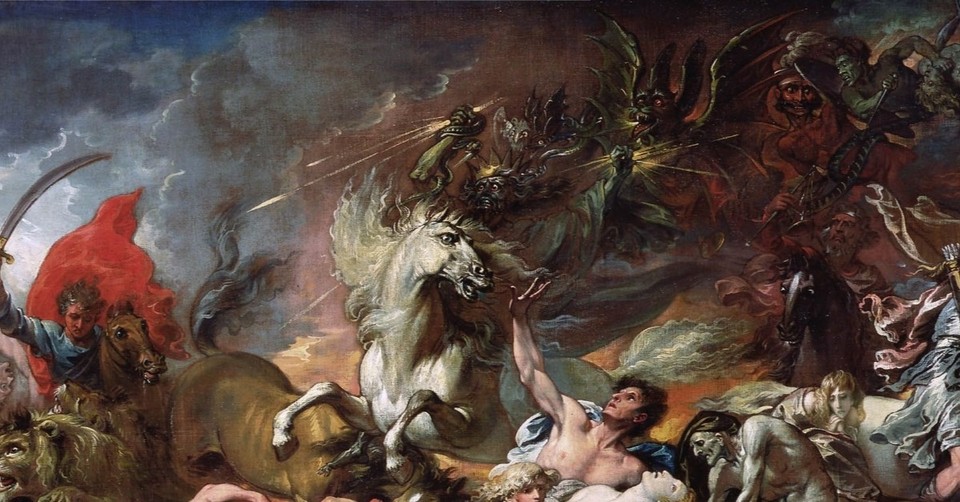Where Is 'Behold a Pale Horse' in the Bible?

We may be tempted to avoid the Book of Revelation because it’s hard to understand and filled with strange phrases like “behold a pale horse.” Sometimes, God’s perspective doesn’t fit our finite human perspectives. As Isaiah 55:8 says, “My thoughts are not your thoughts, neither are your ways my ways.” However, God’s words are still important, particularly when discussing prophetic books like Revelation; studying these words is essential.
Fortunately, we can rely on the Holy Spirit and biblical scholars to help us understand “Behold a pale horse,” and its surrounding verses. My attempt here is to rely on scholars who write about Revelation as futurist eschatology—things that will happen in the future.
What Happens Before Revelation Says “Behold a Pale Horse”?
If we only look at one verse, we miss so much of where it fits in the end times narrative. We have five chapters of important information before we reach the “behold a pale horse” passage.
In the first chapter of Revelation, the writer talks about a vision given by “one like a son of man” (Rev. 1:13). The writer is told to compose a letter to seven churches detailing what he sees. He is greeted by the resurrected Jesus, who gives him these instructions. The next three chapters contain these letters. In Revelation 4, John sees many creatures and 24 elders kneeling before God’s throne and singing praise to “the Lord God Almighty” as John is ushered into heaven to see “what must take place after this” (Rev. 4:1).
Then he sees the One sitting on the throne (i.e., Jesus), holding a scroll with seven wax seals. Dr. Roger Barrier says, “You recall that Jesus said that Satan is now the god of our world. Revelation is the story of how Jesus gets the title deed to his world back. The title deed is a rolled-up scroll sealed by seven drops of wax.”
A mighty angel calls, “Who is worthy to open the seals?” One of the 24 elders answers, “See, the Lion of the tribe of Judah, the Root of David, has triumphed, He is able to open the scroll and its seven seals” (Rev. 5:5). But rather than seeing a lion, the writer sees a lamb that has been slain. The Lamb took the scroll from the One on the throne and began to open the seals.
In Revelation 6, the Lamb opens the first of the seven seals. Scholars who interpret Revelation as a prediction of actual future events argue that this begins the unleashing of cataclysmic events, defeating the evil that has ravaged the earth since the Fall.
Who Wrote Revelation?
According to the Gospel Coalition course on the book, Revelation was most likely written in the mid-90s AD by the same John who wrote the Gospel of John. This would help explain why Revelation refers to Jesus as a lion and a lamb, both images that John uses for Jesus in his gospel.
John experienced these visions while exiled on the Grecian island of Patmos. At the time, the Roman government was violently enforcing emperor worship and persecuting the church intensely. Some warnings written to the seven churches in the first part of Revelation reference the persecution at that time.
Different schools of scholarship debate how much the surprising symbols in Revelation represent the early church’s experience and how much they represent coming events. As I said at the beginning of this article, I’m focusing here on scholars who see Revelation as showing what will happen in the future. Either way, all scholars agree that Revelation provides a big-picture view of good and evil and how God will ultimately defeat evil.
So, how does the pale horse fit into the story of how God will ultimately defeat evil?
How Many Horses Appear Before Revelation Says “Behold a Pale Horse”?
At the opening of Revelation 6, the Lamb begins to open the seven seals. With the opening of the first four, John is called to behold four horses in succession.
The first seal’s opening reveals a white horse whose rider has been given a bow and crown and has ridden out as a conqueror.
The second seal’s opening reveals a “fiery red” horse. “Its rider was given the power to take peace from the earth and to make men slay each other. To him was given a large sword” (Revelation 6:4).
The third seal’s opening reveals a black horse. John observes that its rider holds a pair of scales in his hand. A voice mysteriously says, “A quart of wheat for a day’s wages, and three quarts of barley for a day’s wages, and do not damage the oil and the wine” (Revelation 6:6).
The fourth seal reveals an even more terrifying sight. John is told to “behold a pale horse,” whose rider was named Death, and Hades follows. Together, they receive power “over a fourth of the earth to kill by sword, famine, and plague, and by the wild beasts of the earth” (Revelation 6:8).
What Do These Horses Represent?
To some extent, the kind of terrible events that these four horses and their riders bring (war, famine, disease, and death) have been happening on the earth since the Fall. For many end times scholars, these figures represent a particularly important time: the first of many catastrophes as the end times begin. As Hope Bolinger explains, these events will be associated with the Antichrist (a figure claiming Messianic status and persecuting anyone who doesn’t follow him), who may instigate these wars, famine, and other catastrophes. Only after these events happen will Jesus return to defeat evil.
What does each mean if each horse and rider represents a future event in these dark times?
Barrier observes that the passage “does not say who rides this ‘white horse.’ However, it is most likely the coming Antichrist (Daniel 9:26-27; 1 Thessalonians 5:3) . . . This person is not Christ (cf.Rev 19:11-19). He is Satan's counterfeit of Christ.” Fitting with Daniel 9:27, the horse and rider represent three and a half years of peace followed by three and a half years of war. Many end times scholars argue that a rapture will occur during the end times, in which believers in Jesus will be taken to be with Jesus. Different schools debate whether the rapture will happen before, during, or after the seven years.
Dr. David Jeremiah suggests that the red horse “represents war and bloodshed. Nation will rise against nation during the Tribulation and individuals against each other. It is a time of murder, assassination, bloodshed, revolution, and war.”
Matthew Henry interprets the third horse as: “. . . a black horse, signifying famine, that terrible judgment; and he that sat on the horse had a pair of balances in his hand (v. 5), signifying that men must now eat their bread by weight, as was threatened (Lev 26: 26).” The Levitical reference was when God threatened to remove His gifts from His people if they were disobedient, and that included having enough food to eat.
Anytime that war and famine are combined, death will follow. Scholars have indicated that “pale” didn’t mean just without color; it meant sickly—perhaps even with a greenish tone like dead bodies. Britt Mooney explains that in a futurist view of Revelation, “the pale horse is seen as a literal prophetic figure who will manifest during the end times. Proponents of this view believe the pale horse’s arrival will coincide with actual global pandemics and widespread death as part of the tribulations leading up to Christ’s second coming. The second coming includes the world’s end (or resurrection in some interpretations), the final judgment, and God creating the new heaven and earth.”
David Jeremiah suggests that the pale horse fits with a prophecy in Ezekiel 14:21: “For this is what the Sovereign LORD says: How much worse will it be when I send against Jerusalem my four dreadful judgments—sword and famine and wild beasts and plague—to kill its men and their animals!” Therefore, the pale horse represents the death of those who are left who still do not believe in Jesus.
What Can We Learn from the Pale Horse in Revelation?
There are many events in Revelation before the pale horse appears. More events happen in the next 16 chapters before Jesus destroys evil, creates a new heaven and a new earth, and says, “Behold I am coming soon” (Revelation 22:12). Granting that Revelation is complicated, we can learn some important lessons from this passage.
First, if futurist eschatology is correct, then all or most of what we read in Revelation is a prophecy of what will occur at the end of the age. Jesus gave us this information to help us see what will happen before His second coming. Therefore, we must wrestle with what it says to prepare for the future.
Second, the passage’s imagery makes it difficult to interpret what it means, but we don’t have to study it alone. We can use resources from Matthew Henry and other respected Christian end times experts to understand the context.
Third, looking at how “behold a pale horse” fits with the rest of Revelation shows us that there is a plan for the future. We may struggle to know when the end times will happen. We do know that we will ultimately see how God has worked “all things together for good, to those who love Him and are called according to His purpose” (Romans 8:28). In the end, the entire world will participate in God’s plan to end evil days and renew His perfect world.
Since we don’t know when these things will occur, we do well to make sure we, and all those we know and love, have a saving relationship with Jesus, who holds the keys to the Book of Life. There’s not a moment to waste.
Photo Credit: public domain (1796 painting by Benjamin West)
Mary Oelerich-Meyer is a Chicago-area freelance writer and copy editor who prayed for years for a way to write about and for the Lord. She spent 20 years writing for area healthcare organizations, interviewing doctors and clinical professionals and writing more than 1,500 articles in addition to marketing collateral materials. Important work, but not what she felt called to do. She is grateful for any opportunity to share the Lord in her writing and editing, believing that life is too short to write about anything else. Previously she served as Marketing Communications Director for a large healthcare system. She holds a B.A. in International Business and Marketing from Cornell College (the original Cornell!) When not researching or writing, she loves to spend time with her writer daughter, granddaughter, rescue doggie and husband (not always in that order).
This article is part of our larger resource library of popular Bible verse phrases and quotes. We want to provide easy-to-read articles that answer your questions about the meaning, origin, and history of specific verses within Scripture's context. We hope that these will help you better understand the meaning and purpose of God's Word in your life today.
Originally published August 07, 2024.





